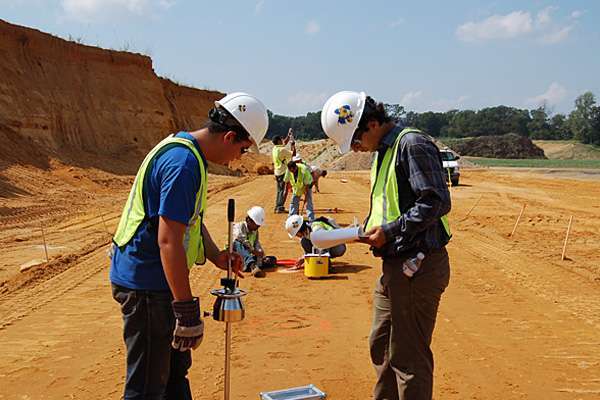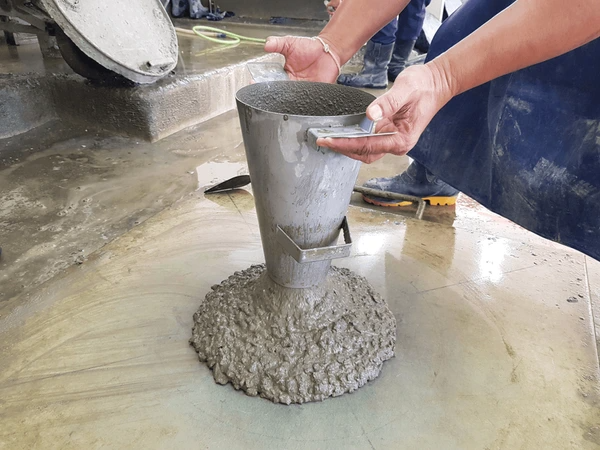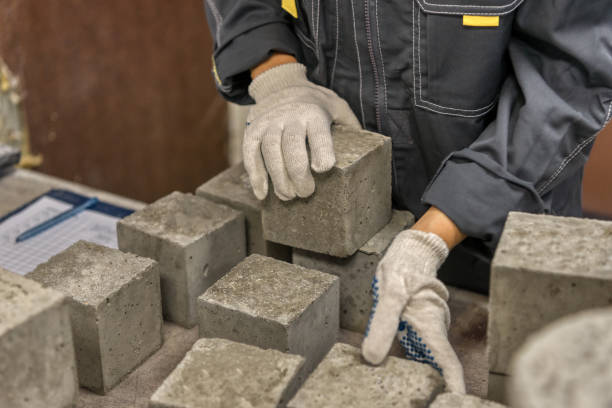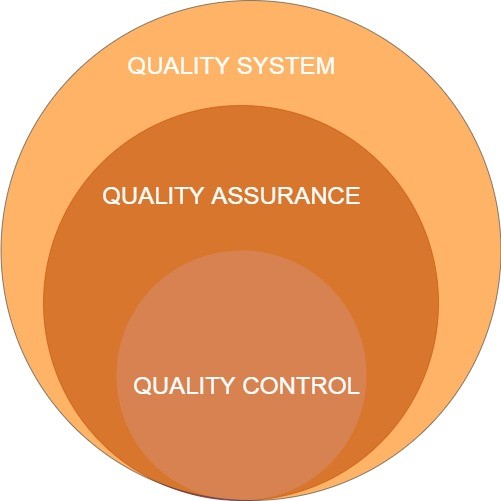Organization

GMILab’s Mission
To provide reliability, honesty, professionalism and excellence in material testing through adoption of standard procedures, modern equipment and innovative techniques

GMILab’s Motto
“Worth building, worth testing”

GMILab’s Vision
To be the leading laboratory in geotechnical and material investigation, testing and research
Ground and Site Investigation
- Drilling services
- Plate bearing test
- Soakage test
- Difficult/restricted access sites
- Instrumentation and monitoring
- CBR test
- Dynamic probing
- Borehole soakaways
Ground and Site Investigation
Geotechnical Soil and Rock Testing

Classification Testing | ||
|---|---|---|
| Natural Moisture Content; MC | Natural Moisture Content; MC | The mechanical properties of a soil often depend on their moisture content and the test is used in assessment of soil profiles, strength, drying etc. |
| PSD Grading by Wet & Dry Sieve Methods | BS1377-2:9.2 & 9.3 & BS EN ISO 17892-4 | Particle size expresses the size of the particles comprising a soil in terms of percentages by weight of individual sizes. This analysis is used for classification of sands and gravels and coarser particles. This can be related to the mechanical properties of the material e.g. suitability as a fill material, permeability etc. |
| PSD by Pipette Method (sedimentation) | BS1377-2:9.2 & 9.3 & BS EN ISO 17892-4 | Used in conjunction with a sieve analysis to determine the silt and clay content of a soil. Used in the classification of soil and assessment of their mechanical properties. |
| Particle Density; PD or Specific Gravity; SG | BS1377-2:8 & BS EN ISO 17892-3 | Used for the determination of porosity and voids ratio. Frequently used in road construction in the determination of the state of compaction of fill materials. |
| Used for the determination of porosity and voids ratio. Frequently used in road construction in the determination of the state of compaction of fill materials. | BS1377-2:7 & BS EN ISO 17892-2 | The density of soils depends on the density of the solid particles, on the porosity and the moisture content. The dry density is used in the evaluation of porosity and voids ratio. It is frequently used in road construction for the determination of the state of compaction of fill material. |
| Plasticity Index (Atterberg Limit Test); PL, LL & PI | BS1377-2:4 – 5 & BS EN ISO 17892-12 | The properties of cohesive soils are strongly influenced by the mineralogy of the clays. These tests along with moisture content are used for classification and to assess mechanical properties and are used for Earthworks Materials, Volume Change potential, drying etc. |
Chemical Testing | ||
| pH value | BS1377-3:9.5 | A measure of the acidity/alkalinity of soil and groundwater. Concrete that is subject to highly mobile acid (low pH) water can deteriorate rapidly. This is assessed for concrete design. |
| Sulphate Content | BS1377 | A measure of the sulphate content of soil and groundwater. These sulphates can attack concrete leading to its deterioration. This is assessed for concrete design. |
| Organic Content | BS1377-3:3 & 4 | Derived from the decomposition of plant, animal and bacterial life. The organic material shows high water absorption and strongly influence mechanical properties especially strength and settlement behaviour. |
| Chloride Content | BS1377-3:7 | This test measures chloride content of soil and water. Only very high concentrations affect unreinforced concrete but could attack steel at lower concentrations. |
Performance Testing | ||
| Dry Density Moisture Content Relationship (Compaction); DD/MC, OMC & MDD | BS1377-4:3 | This test measures the dry density of the compacted soil in relationship to moisture content depending on the manner of the compaction effort. Compaction influences the shear strength and compressibility of the soil and is frequently used in earthworks and road construction. |
| Laboratory Californian Bearing Ratio; CBR | BS1377-4:7 | Used for the evaluation of sub-grade strength in road design. The test measures the load required to cause a plunger to penetrate a specimen of soil. Although an arbitrary test it is an indirect measure of strength. Not suitable for materials with more than 25% of particles larger than 20mm. |
Consolidation Testing | ||
| One Dimensional Consolidation (Oedometer) | BS1377-5:3 & BS EN ISO 17892-5 | The rate and degree of settlement from a proposed structure is estimated from this small-scale laboratory test for soil investigation. A soil sample is compressed within a metal mould sandwiched between porous plates. A change in thickness is measured at different loads. |
| Swelling Pressure | BS1377-5:4 & BS EN ISO 17892-5 | In the oedometer swelling potential can be assessed |
Shear Testing | ||
| Immediate Undrained Shear box | BS1377-7:4 & BS EN ISO 17892-10 | Undrained estimates of the shear strength of soils can be measured under different normal stresses. In the shear box failure is caused in a predetermined plane of the soil. True immediate tests cannot be made in material not fully saturated or in more permeable soils. |
| Consolidated Drained Shear box | BS1377-7:4 & BS EN ISO 17892-10 | The soils in the shear box are allowed to consolidate under a vertical load and then sheared slowly. The results are usually used in assessment of slope stability and retaining wall design. |
| Laboratory Vane | BS1377-7:3 | The torque required to cause shearing of soil from twin blades fixed at right angles. The test allows the measurement of shear strength for foundation design and road pavements. They can assist in stability of earthworks. |
Triaxial Testing | ||
| Quick Undrained Triaxial | BS1377-7:8 | A soil sample is subjected to three stresses at right angles with the vertical stress increased until the specimen fails. The test results are used for the design of conventional and piled foundations but can also be used in short term stability of slopes and underground openings. |
Effective Stress Testing | ||
| Isotropically Consolidated Undrained Test | BS1377-8:7 | An effective strength test where the sample is consolidated to a mean effective stress and the undrained strength and pore water pressure is measure. In an undrained test the volume remains constant. Stability of slopes and design of retaining structures. |
| Isotropically Consolidated Drained Test | BS1377-8:8 | This test is for the long-term condition of the above test. This is usually carried out in sands and free draining materials. In the drained test the pore pressure remains constant but the volume may change. Stability of slopes and design of retaining structures. |
Permeability Testing | ||
| Direct Measurement of Permeability under Constant Head | BS1377-5 & 6 | Measures the coefficient of permeability usually in cohesive soils in the Triaxial apparatus. This is frequently used in the assessment of permeability in compacted soils in landfill and road construction. |
Rock Testing | ||
| Measurement of Uniaxial Compressive Strength; UCS | ISRM Part 1 2007 | The rock/soil strength is determined from a uniaxial compressive strength on a cylindrical specimen. Often used to assess the strength of rock for foundation design. The strength can also be used on the stability of rock slopes and underground openings. It should be noted that this strength only refers to the solid parts of a rock mass. |
| Point Load; PL | ISRM 2007 | Where uniaxial strengths cannot be directly measured the point load tests offers a possible alternative method of assessment. |
The above tables do not list all available tests. Want to find out more about our geotechnical soil testing services? Please contact our laboratory manager to discuss your site investigation testing requirements.
Aggregates and Earthworks Testing
Our in-house laboratories are equipped to provide comprehensive aggregates and earthworks testing services which meet the appropriate British and American Standards. As well as completing standard laboratory, grading, compaction and classification earthworks testing, we also provide engineering advice and assistance with the design and specification for a variety of earthworks operations, as well as undertaking on site monitoring and in-situ testing. Mechanical, physical and chemical testing is undertaking for a variety of Clients on a wide range of natural and recycled aggregates to ensure they are fit for purpose. We also offer a thorough on-site material assessment and sampling service.

Earthworks Testing | ||
|---|---|---|
| Natural Moisture Content | BS1377-2:3 & BS EN ISO 17892-1 | The mechanical properties of a soil often depend on their moisture content and the test is used in assessment of soil profiles, strength, drying etc. |
| Plasticity Index (Atterberg) | BS1377-2:4 & 5 & BS EN ISO 17892-12 | The properties of cohesive soils are strongly influenced by the mineralogy of the clays. These tests along with moisture content are used for classification and to assess mechanical properties and are used for Earthworks Materials, Volume Change potential, drying etc. |
| Particle Density | BS1377-2:8 & BS EN ISO 17892-3 | Used for the determination of porosity and voids ratio. Frequently used in road construction in the determination of the state of compaction of fill materials. |
| Bulk & Dry Density | BS1377-2:7 & BS EN ISO 17892-2 | The density of soils depends on the density of the solid particles, on the porosity and the moisture content. The dry density is used in the evaluation of porosity and voids ratio. It is frequently used in road construction for the determination of the state of compaction of fill material. |
| Grading to ‘Highways’ | BS EN 933-2, BS 1377-2 & BS EN ISO 17892-4 | A particle Size Distribution (PSD) test used for grading of aggregates and earthworks materials to determine suitability using Grading Limits and Coefficient of Uniformity. |
| PSD by Pipette Method (sedimentation) | BS1377-2:9.2, 9.3 & BS EN ISO 17892-4 | Used in conjunction with a sieve analysis to determine the silt and clay content of a soil. Used in the classification of soil and assessment of their mechanical properties. |
| Dry Density Moisture Content Relationship (compaction) | BS1377-4:3 | This test measures the dry density of the compacted soil in relationship to moisture content depending on the manner of the compaction effort. Compaction influences the shear strength and compressibility of the soil and is frequently used in earthworks and road construction. |
Aggregates Testing | ||
| Presence & ID of Asbestos | HSG 248/RECASB01 | Required before carrying out Laboratory Testing on materials derived from demolition waste such as Recycled Aggregates (RA). |
| Particle Identification (Clause 710) | BS EN 1097-2 | Determines resistance to fragmentation of aggregates |
| Micro Deval Abrasion | BS EN 1097-1 | Determines resistance to wear of aggregates. |
| Sulphate & Oxidizable Sulphides Content | TRRL 447 1, 2 & 4 | Limits are set on how close a material bearing sulphates and sulphides can be to concrete and steel members in earthwork structures. |
| Topsoil Compliance including Contamination Suite | BS3882:2015 | Determines the suitability of a topsoil for various applications. |
The above tables do not list all available tests. Please contact us to discuss your site investigation testing requirements.
Construction Materials Testing
Our in-house laboratories are equipped to provide comprehensive construction materials testing services which meet the appropriate British and American Standards. We commonly carry out Concrete Cube and Concrete Core compressive strength testing as well as mechanical, physical and chemical testing of natural and recycled aggregates to ensure they are fit for purpose. A wide range of other construction materials testing is available. Materials testing capabilities offered through external laboratories also include void content of core sample, PRD tests, blacktop analysis, binder recovery, bitumen penetration and bitumen softening point. We also offer a thorough on-site material assessment and sampling service.

| Concrete Cube Compressive Strength | BS EN 12390-3 | Determines the strength of hardened 100 – 150mm concrete cubes usually at 7, 14 and 28 days after casting. Used as quality control during construction of concrete structures. |
| Depth of Carbonation (by Phenolpthalein indicator) | BS EN 14630 | This test is used to establish whether the pH of concrete has reduced. A lower pH can allow corrosion of reinforcement. |
| Sulphate Content | BS1881-124 | Used to assess whether concrete in a structure is likely to have been attacked by sulphates. |
| Chloride Content | BS1881-124 | Used to assess whether concrete in a structure is likely to have been attacked by chlorides. |
| Presence & ID of Asbestos | HSG 248/RECASB01 | Required before carrying out Laboratory Testing on materials derived from demolition waste such as Recycled Aggregates (RA). |
| Grading to ‘Highways’ | BS EN 933-2 & BS1377-2 | A particle Size Distribution (PSD) test used for grading of aggregates and earthworks materials to determine suitability using Grading Limits and Coefficient of Uniformity. |
| Particle Identification (Clause 710) | MCHW Cl. 710 | Determines the composition of Recycled Aggregates (RA) |
| Los Angeles Abrasion (LA) | BS EN 1097-2 | Determines resistance to fragmentation of aggregates |
| Micro Deval Abrasion | BS EN 1091-1 | Determines resistance to wear of aggregates. |
The above tables do not list all available tests. Please contact our laboratory manager to discuss your site investigation testing requirements.
Concrete Testing

| Concrete Cube Compressive Strength | BS EN 12390-3 | Determines the strength of hardened 100 – 150mm concrete cubes usually at 7, 14 and 28 days after casting in cleaned, oiled steel moulds. Used as quality control during construction of concrete structures |
| Concrete Core Compressive Strength | BS EN 12504-1, 12390-3 & 12390-7 | Used to assess the strength of concrete in existing structures. |
| Depth of Carbonation (by Phenolpthalein indicator) | BS EN 14630 | This test is used to establish whether the pH of concrete has reduced. A lower pH can allow corrosion of reinforcement. |
| Sulphate Content | BS1881-124 | Used to assess whether concrete in a structure is likely to have been attacked by sulphates. |
| Chloride Content | BS1881-124 | Used to assess whether concrete in a structure is likely to have been attacked by chlorides. |
The above tables do not list all available tests. Please contact us to discuss your site investigation testing requirements.
Ground and Site Investigation
Geotechnical Investigation

Our key areas of site investigation geotechnical consultancy include:
- Initial Site Investigation / Site Appraisal
- Phase 1 Geotechnical Desk Study
- Subsidence or Heave Investigations and Underpinning Design
- Slope Engineering and Slope Stabilisation
- Temporary and Permanent Works
- Earthworks design and monitoring
- Ground Improvement and Soil Stabilisation
- Road and Temporary Works Platforms
- Soakaways and Stormwater Managements
- Pipeline Route Evaluation, Ground Characterization, Engineering Analysis and Thrust Block Design
- Ground Instrumentation and Monitoring
Foundations and Substructure
- Site Investigation
- Bearing Pressures
- Foundations
- Ground Improvement
- Basements Design and Analysis
- Complex Settlement Analysis
- Swelling and Shrinkage Ground Investigations
- Load Transfer Platform Analysis & Design
- Pipeline Investigation & Thrust Block Design
- Expert Witness
- Pile Design and Analysis
Slopes and Retaining Structures
We have a wealth of experience investigating slopes which have either failed naturally, or where a risk of slope failure has been recognized on engineering works. Slope failure can occur in natural circumstances or as a result of poorly designed engineering works. Examples of natural slope failures are seen when groundwater conditions change and when erosion occurs. Examples of failure due to poor engineering design are seen where cuttings are made into slopes particularly where pre-existing slip surfaces exist, slopes are surcharged, changes are made in groundwater regimes, or where vegetation / tree cover is removed. Our ground investigation engineering and technical team has experience in:
- Designing the Site Investigation
- Undertaking the Fieldwork / Restricted Access Rigs
- Installation of Instrumentation
- Long- and Short-Term Monitoring
- Geomorphological and Hazard Mapping
- Detailed Slope Analyses
- Advising & Designing Slope Remedial Schemes
- Slope Stabilisation
- Retaining structures – Reinforced Soil Slopes, Soil Nails, Retaining Walls, Crib walls, Gabion Walls
- Overseeing the Installation of the Chosen Design

Soakaways
- NHBC: Chapter 5.3; Percolation Test for Surface Water Soakaways (Small-scale)
- BS 6297: 2007; Percolation Test for Septic Tank Insulations (Small-scale)
- BS 5930: 1999; Falling Head Test in Boreholes (Small-scale)
- BRE Digest 365: 1991; Falling Head Test in Trial Pits (Large-scale)
- BS 5930; 1999; Constant Head Test in Boreholes (Large-scale)
Soakaways
- NHBC: Chapter 5.3; Percolation Test for Surface Water Soakaways (Small-scale)
- BS 6297: 2007; Percolation Test for Septic Tank Insulations (Small-scale)
- BS 5930: 1999; Falling Head Test in Boreholes (Small-scale)
- BRE Digest 365: 1991; Falling Head Test in Trial Pits (Large-scale)
- BS 5930; 1999; Constant Head Test in Boreholes (Large-scale)
Earthworks and Ground Improvement
Tailored Services
- Acoustics
- Noise
- Vibration
- Dust and air quality
- Flood Risk
- Coastal Erosion
- Archaeology
- Cultural Heritage
- Ecology
- Environmental Management
- Sustainability
KEY STAFF
Assoc. Prof. Umaru Bagampadde
Eng. Samuel Jjuuko
- AutoCAD,
- AutoCAD Land Development,
- AutoCAD CIVIL 3D for geometric road designs,
- EPANET,
- AutoCAD Storm and Water Analysis,
- EPACAD,
- Archaeology
- GEOSLOPE for soil slope stability analysis,
- Rocscience Phase2 for rock excavation and tunnel design,
- Rocscience RocLab for rock foundation design,
- Rocscience Swedge for soil and rock settlement analysis, and
- Rocscience RocSupport for tunnel design in weak rocks.
- Rocscience CPillar, Dips, Examine3D, RocData, RocFall, RocPlane, RocTopple, RS2, RS3, Settle3D, Slide and Unwedge
Dr. Robinah Kulabako

EXPERIENCE
- Hydrogeological and Geotechnical Investigations for Latoro Small Hydro Power Project in Uganda
- Geotechnical Investigations for NWSC Sewage Treatment Plant and Water Treatment Plant at Sino-Mbale Industrial Park
- Design and build of Kishuro Bridge in Birere subcounty, Isingiro DLG
- Consultancy Services for Detailed Engineering Design of Various Low Volume Roads Using Appropriate Low-Cost Sealing Technology, Lot 10: Arua-Giligili-Ovision Road
- Geotechnical Investigation for the Proposed Science Block at University of St. Joseph, Nyamitanga Hill, near Nyamitanga Cathedral opposite Holy Innocents Children’s Hospital on Mbarara-Kikagate Road
- Geotechnical Investigations for the Design and Construction of the Proposed Neonatal Intensive Care Unit (NICU) Building at Holy Innocents Children's Hospital on Plot 6, Kaberebere-Insingiro Road, Mbarara, Uganda
- Geotechnical Investigations for the Proposed Mixed Developments, Shops and Apartments, on Plot No. 68 Block No. 219, NajjeKira Municipality, Wakiso District
- Consultancy Services for Feasibility Studies and Preliminary Design of Multi-Purpose Storage Dams and Watering Facilities in Karamoja
- Consultancy for Detailed Design and Supervision of Earth Dams and Multipurpose Water Systems and Facilities of Lot 3: Kyenshama Earth Dams in Mbarara District
- Consultancy Services for Detailed Design and Supervision of Earth Dams and Multipurpose Water Systems and Facilities of Lot 1: Geregere Earth Dam and Watering Facilities in Agago District
- Environmental Project Brief of Feeder Line Supplementary Geotechnical and Geophysical Survey and Geo-hazard Assessment
- Geotechnical Investigation for the Proposed Mixed Developments, Shops and Apartments, on Plot No. 157 Block No. 214, Kisaasi, Kawempe Division, KCCA
- Geotechnical Investigation for the Proposed Apartments on Plot 1753, Block 216 Kyadondo, Kalinabiri II zone, Ntinda, Nakawa Division, KCCA
- Geotechnical investigations, design and supervision of the construction of water tanks at the premises of Skyfat Tannery Company Limited located on Plot 6&7 off Nyanza Close, Jinja District, Uganda
- Geotechnical Investigation Report for the Proposed Commercial Building at Kyadondo Block 215, Plots 610 & 2765, Kulambiro, Nakawa Division, KCCA
- Geotechnical Investigations for Proposed Classroom block at WISDOM Primary School, on Block No. 203, Lugala Town, Lubaga Division, Kampala District
- Geotechnical Investigation for Proposed Apartments on Block No…. in Mujomba Zone 6, Nakulabye Parish, Lubaga Division, KCCA
- Feasibility Studies and Detailed Engineering Design of 2 Selected Earth Dams and Multi-Purpose Water Systems in Districts of Kaabong, Abim and Kotido
GMILab has experience in geotechnical and material investigations for the following scope of works:
Small hydroelectric power dams and related facilities
Earth dams and related facilities
Water and wastewater treatment facilities
Buildings (residential and commercial)
Highways/roads and related activities
Oil and gas facilities